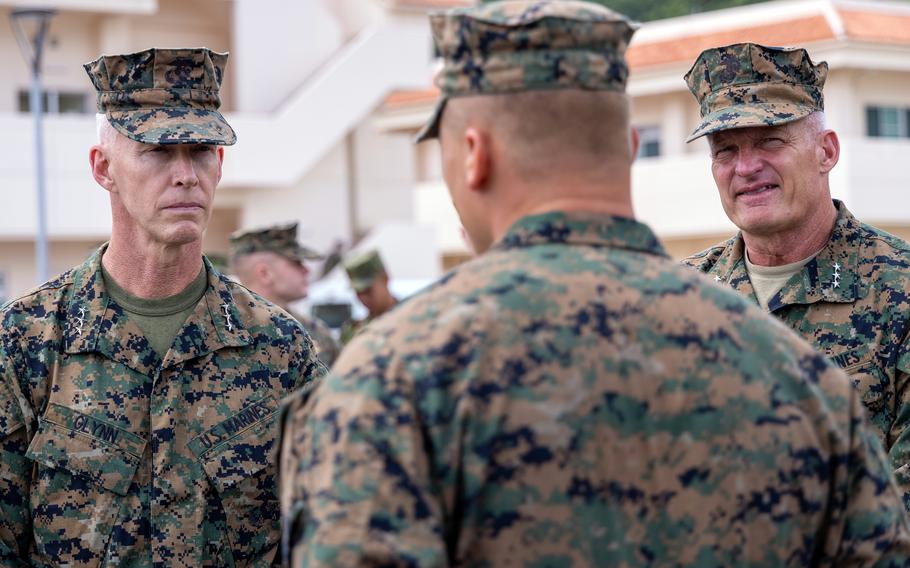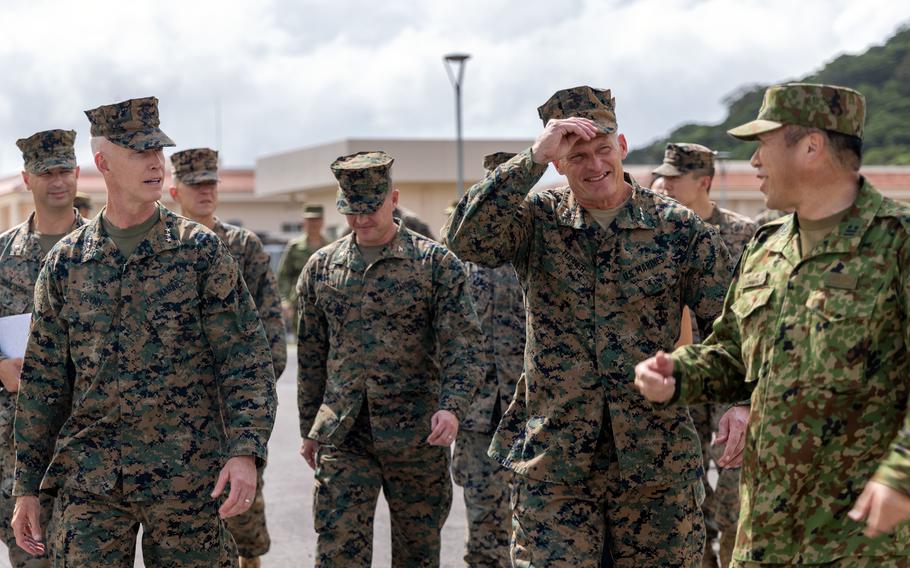
Lt. Gen. James Glynn, left, commander of Marine Corps Forces Pacific, and Lt. Gen. Roger Turner, right, head of III Marine Expeditionary Force, speak to a Marine on Japan’s Ishigaki Island, Oct. 23, 2024. (JVonnta Taylor/U.S. Marine Corps)
CAMP FOSTER, Okinawa — The general in charge of the Marine Corps’ Indo-Pacific field command recently visited Ishigaki island for the first time, signaling U.S. resolve to defend Japan as it faces increasing provocations from China, according to regional experts.
Marine Corps Forces Pacific commander Lt. Gen. James Glynn was at the Japanese army’s Camp Ishigaki on Oct. 23 for the start of the U.S.-Japan Keen Sword exercise, the III Marine Expeditionary Force announced Friday. He was joined by the head of III MEF, Lt. Gen. Roger Turner.
The visit marked the first time a leader of the Marines’ largest field command visited the Sakishima chain, of which Ishigaki is a part, according to the III MEF news release. Ishigaki is about 150 miles east of Taiwan, an island democracy over which China claims sovereignty.
China’s military has mounted at least two large exercises this year demonstrating its ability to storm or blockade the island.
“Commander [Marine Forces Pacific] making a public visit to Ishigaki is a clear statement that the Marines are playing an active role in defending Japan – and in an area that is in the [Chinese army’s] crosshairs and where a potential fight with the Chinese is most likely to occur,” retired Marine Col. Grant Newsham, a senior researcher with the Japan Forum for Strategic Studies in Tokyo, told Stars and Stripes via email Wednesday.
Retired Lt. Gen. Toshiyuki Shikata, formerly of the Japan Ground Self-Defense Force, agreed, saying by phone Wednesday that the visit “shows the opponent, China, that the U.S.-Japan alliance in the Nansei region is getting stronger.”
The Nansei island chain, also known as the Ryukyu islands, stretch from just east of Taiwan to Kyushu, the southernmost of Japan’s four main islands. Okinawa is the largest island in the chain, which forms a barrier that controls East China Sea approaches to the coast of China.

Lt. Gen. James Glynn, left, commander of Marine Corps Forces Pacific, and Lt. Gen. Roger Turner, second from right, head of III Marine Expeditionary Force, visit Camp Ishigaki on Japan’s Ishigaki Island, Oct. 23, 2024. (JVonnta Taylor/U.S. Marine Corps)
While on Ishigaki, Glynn and Turner met with Marines of the 12th Marine Littoral Regiment, the Corps’ newest seaborne quick-reaction force, according to the release. Littoral regiments are smaller, mobile units inserted within enemy missile range to seize and hold key islands and deny vessels access to surrounding areas.
The two Marine generals also met with Japanese troops stationed on the island and with Ground Self-Defense Force leaders to “address current security concerns and continued support to the defense of Japan,” the release said.
The visit is something that “potential aggressors ought to take notice” of, according to Newsham.
“The Chinese threat has become such that the U.S. and Japan are less reticent about sending messages about their joint resolve,” he wrote.
The full text of Glynn and Turner’s discussions were not available, III MEF spokesman Capt. Pawel Puczko said by email Tuesday. He said the commanders spoke about Keen Sword’s “ability to demonstrate and advance U.S.-Japan interoperability.”
The U.S. military frequently uses interoperability to describe the ability of one country’s armed forces to use another’s training methods and military equipment.
Turner highlighted the 12th Littoral Regiment’s importance to the Marines’ modernization effort in a quote relayed by Puczko via email. The regiment’s stand-in force operations are a key tenet of the island-fighting doctrine featured in the Marines’ Force Design plan.
“III MEF is optimally postured to conduct sensing and targeting in defense of our allies and partners,” Turner said. The regiment’s “sensing capabilities enhance the [Japanese Self-Defense Forces’] maritime targeting and sea control efforts. We look forward to expanding the scope of realistic cross-domain training, tabletop exercises, and exercises.”
Newsham said Turner is making “a pitch for Force Design 2030,” the original name for the Force Design concept.
“It would be nice if a senior U.S. Navy or Japan [Maritime Self-Defense Force] officer — rather than a senior Marine officer — had made this statement — and specifically noted that the Marines are providing essential and indispensable ‘sensing’ and ‘targeting’ that cannot be provided by other platforms operated by other services,” he wrote.
Stars and Stripes reporter Keishi Koja contributed to this report.